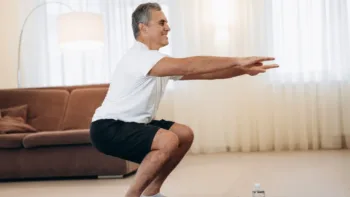
Functional fitness is a trend that’s taking the fitness world by storm, and for good reason. Unlike traditional workouts that often focus on isolating specific muscles, functional fitness aims to train your body for real-life activities.
This article will explore what functional fitness is, its benefits, and how you can incorporate it into your daily routine to improve your overall health and well-being.
What is Functional Fitness?
Functional fitness is a type of exercise that prepares your body for everyday activities by simulating common movements you might do at home, work, or in sports. The goal is to enhance your ability to perform daily tasks with ease, efficiency, and safety.
This type of fitness program focuses on building a body capable of doing real-life activities in real-life positions, not just lifting a certain amount of weight in an idealized posture created by a gym machine.
The essence of functional fitness lies in its practicality. Instead of isolating muscles with repetitive motions, it emphasizes compound movements that engage multiple joints and muscle groups.
These exercises are designed to improve strength, endurance, balance, coordination, and flexibility. By training your body to work as a cohesive unit, functional fitness can help you move more efficiently and safely in your everyday life.
The Potential Benefits of Functional Fitness
1. Improved Daily Life: One of the main benefits of functional fitness is its direct impact on daily activities. Movements like bending, twisting, lifting, and reaching can become easier and more efficient, reducing the risk of injury. Whether you’re carrying groceries, playing with your kids, or doing household chores, functional fitness can make these tasks less strenuous.
2. Enhanced Strength and Coordination: Functional fitness exercises engage multiple muscle groups and joints, improving your strength, balance, and coordination. This holistic approach ensures that your body works as a cohesive unit. For example, a lunge involves not just your legs, but also your core and stabilizing muscles, promoting overall body strength.
3. Better Posture and Flexibility: Many functional fitness exercises promote better posture and flexibility. By focusing on movements that require proper alignment, you can correct imbalances and reduce pain associated with poor posture. For instance, exercises that strengthen your core can alleviate back pain and improve your posture over time.
4. Increased Mobility and Stability: Functional fitness helps improve your range of motion and stability, which is crucial for maintaining independence as you age. Exercises like squats and planks enhance joint flexibility and muscle strength, enabling you to move more freely and confidently.
5. Efficient Workouts: Because functional fitness exercises often involve compound movements that work several muscle groups at once, you can achieve more in less time. This makes it a great option for those with busy schedules. A single functional fitness session can provide a full-body workout, maximizing the efficiency of your exercise routine.
Examples of Functional Fitness Exercises
Here are some common functional fitness exercises that can help you get started:
- Squats: Squats are a fundamental functional exercise that targets your legs and core. They mimic the movement of sitting down and standing up, making daily activities like getting in and out of chairs easier. Start with bodyweight squats and gradually add resistance with weights or resistance bands.
- Lunges: Lunges strengthen your legs and improve your balance. They replicate movements like stepping forward to reach something or getting up from a kneeling position. You can perform lunges in various directions—forward, backward, or sideways—to engage different muscle groups and enhance your stability.
- Push-ups: Push-ups are excellent for building upper body strength. They engage your chest, shoulders, and triceps while also working your core. If standard push-ups are too challenging, start with modified versions like knee push-ups or incline push-ups.
- Planks: Planks are great for core stability. They help improve your posture and build endurance in your abdominal muscles. You can increase the intensity by adding variations like side planks or plank rotations.
- Deadlifts: Deadlifts train your body to lift objects from the ground safely, using your legs and back. This exercise is especially useful for preventing lower back injuries. Start with light weights and focus on maintaining proper form to avoid strain.
- Farmer’s Walk: This exercise involves walking while holding weights at your sides, simulating the action of carrying groceries or other heavy objects. It’s a fantastic way to improve your grip strength and overall endurance.
Tips for Integrating Functional Fitness into Daily Routines
Incorporating functional fitness into your daily routine doesn’t have to be complicated. Here are some tips to help you get started:
1. Start Slow: If you’re new to functional fitness, begin with basic exercises and gradually increase the intensity. Focus on form and technique to prevent injuries. It’s important to master the foundational movements before adding weights or increasing complexity.
2. Use Body Weight: You don’t need fancy equipment to do functional fitness exercises. Many movements can be performed using just your body weight. Bodyweight exercises like squats, lunges, and push-ups can be done anywhere, making it easy to incorporate them into your routine.
3. Incorporate into Daily Activities: Look for opportunities to incorporate functional movements into your daily routine. For example, practice squats while picking up items from the floor or do calf raises while brushing your teeth. Turn mundane tasks into mini workouts to keep your body active throughout the day.
4. Create a Balanced Routine: Ensure your workout routine includes a mix of strength, flexibility, and balance exercises. This balanced approach will help you develop a well-rounded fitness level. A typical week might include strength training on some days and flexibility or balance exercises on others.
5. Stay Consistent: Consistency is key to seeing results. Aim to include functional fitness exercises in your routine at least three times a week. Set realistic goals and gradually increase the duration and intensity of your workouts as your fitness improves.
6. Seek Professional Guidance: If you’re unsure where to start, consider working with a fitness professional. They can create a personalized program that suits your needs and goals. A trainer can also provide valuable feedback on your form and technique, ensuring you get the most out of your workouts.
7. Make it Fun: Find ways to make your functional fitness routine enjoyable. Join a group class, try new exercises, or listen to your favorite music while working out. The more you enjoy your workouts, the more likely you are to stick with them.
Functional fitness is more than just a workout trend; it’s a practical approach to improving your daily life. By focusing on movements that enhance your ability to perform everyday tasks, you can enjoy better strength, coordination, and overall health.
Whether you’re picking up groceries, playing with your kids, or just moving through your day with ease, functional fitness can make a significant difference. So why not give it a try and see how it can enhance your everyday movements?
Remember, the key to success with functional fitness is consistency and progression. Start with simple exercises, gradually increase the intensity, and always prioritize proper form.
With time and dedication, you just might notice improvements in your daily life, making every movement easier and more enjoyable. So lace up your sneakers, find a workout space, and start your journey towards a more functional and fit you!
By Admin –







